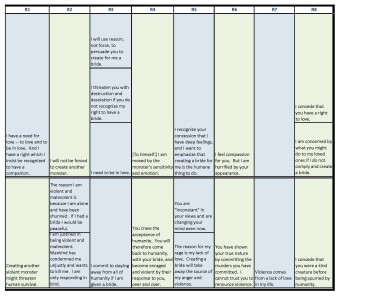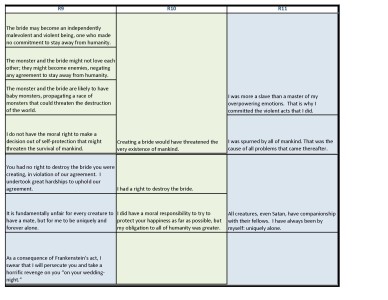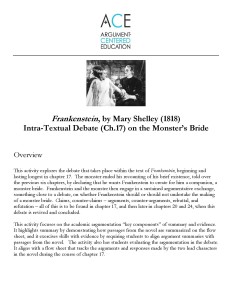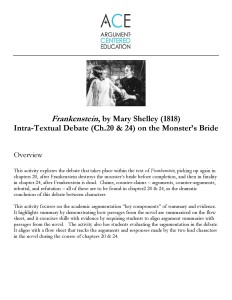
Intra-Textual Debate Tracking and Evaluation in ‘Frankenstein,’ by Mary Shelley (1818)
Another fruitful and engaging angle in on academic argumentation in the classroom is to have students track a debate and evaluate the argumentation taking place within a text, fictional or informational.
This activity explores the debate that takes place within the text of Mary Shelley’s Gothic and Romanticist masterpiece Frankenstein (1818), beginning shortly after the monster re-appears to Frankenstein and tells his mournful story of his isolation and loneliness. The monster ends the recounting of his brief existence by declaring that he wants Frankenstein to create for him a companion, a monster bride. Frankenstein and the monster then engage in a sustained argumentative exchange, something close to a debate, on whether Frankenstein should or should not undertake the making of a monster bride. Claims, counter-claims – arguments, counter-arguments, rebuttal, and refutation – all of this is to be found in the debate the novel’s two main characters have, sustained over the final third of the book.
Argument-Centered Education’s activity focuses on the academic argumentation “key components” of summary and evidence. It highlights summary by demonstrating how passages from the novel are summarized on the flow sheet, and it exercises skills with evidence by requiring students to align argument summaries with passages from the novel. The activity also has students evaluating the argumentation in the debate. It aligns with a flow sheet that tracks the arguments and responses made by the two lead characters.
The flow sheets are crucial — of course! — to track the argumentation offered by the characters, to identify the arguments made, the counter-arguments used to respond to those arguments, the reasoning used to refute the developing and on-going argumentation over whether Frankenstein should or should not create a bride for the monster.
The activity forms themselves ask students to align text from the relevant chapters to back up each argument made by Frankenstein and the monster, over the course of their debate. They also ask students to evaluate the intra-textual debate around these questions:
1. Frankenstein ends chapter 17 agreeing to create a bride for the monster – essentially conceding the debate to the monster. Explain why his concession of the debate was justified, and why the monster had the better argumentation.
2. How could Frankenstein have won this debate in chapter 17? What arguments would he have had to make (that he didn’t) in order to have had the superior arguments? Or do you think he actually did win the debate, and he should not have conceded? Explain with reference to the text.
3. Frankenstein makes arguments about the threat that creating a monster’s bride would pose to mankind, particularly in chapter 20, that the monster doesn’t directly or fully answer. What are those arguments and what implications do they have on the debate as a whole?
4. In what 2 – 3 ways does the debate between Frankenstein and the monster demonstrate and underline the novel’s Romanticism?
There are — if not an unlimited — a vast range of approaches to tap in an argument-centered classroom. Limited to two students standing up in front of the room, debating the pro’s and cons of an obvious controversial issue it is not. Tracking, honing in on, aligning with text, and evaluating the debates that occur within complex, literary texts is just one of the many academically rigorous ways of designing and implementing argument-centered instruction.





